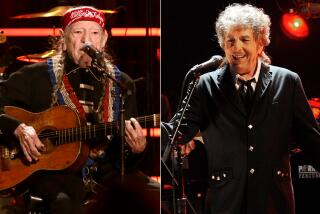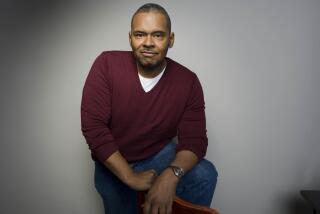Performance Artist Salmon Taps Into Mythology
- Share via
Will Salmon flings dancer Betty Nash violently to the floor of the Boyd Street Theatre, wildly vocalizing as if he were a postmodern Tarzan who has met up with a swarthy Meredith Monk instead of Jane.
But the high-pitched bird calls aren’t in sync with the movement and Salmon disrupts the rehearsal to rework a moment with Nash, displaying the evenness he’s known for.
This shifting of psychic gears from manic stage character to mild-mannered director is so extreme that even Salmon makes a point of commenting on the differences between the two.
“It’s a lot more exciting playing someone other than yourself,” he says to tuba player Bill Roper during this rehearsal of “Seeds,” a program of two works by Nash and Salmon.
“Seeds,” which received its premiere Friday at Pipeline’s Boyd Street Theatre, will continue through Saturday.
“You can really get beyond your inhibitions when you don’t have to worry that you’re making a fool of the real you,” he adds.
If Salmon sounds like a typical actor, he’s not. As the writer and performer in his own work about Homer’s Odysseus, he knows he occupies some quasi-middle ground between Salmon the human being and the character he plays, and thus feels comfortable enough with the label of performance artist.
But unlike many performance artists, Salmon would rather not use autobiography as a theatrical building block.
“I prefer tapping into mythological figures like the Apostle Peter or Odysseus who form our collective cultural inheritance,” he explains. “My work is about finding the way to go beyond ourselves.”
Salmon’s last work, “Heart Beaten,” was his most autobiographical and, he admits now, “my least favorite.”
In that piece, a mad flutist reminisced about his yuppie wife and the painful gaps between them that resulted in divorce. “I don’t ever want to be so damn obvious again,” he confesses.
“An artist is like a shaman,” Salmon explains. “He has to find the deepest part of himself, and take his audience on a journey through sorrow and the inner light.
“I don’t know how much I believe in Jung’s collective theory of the unconscious, but in a (James) Joycean way, I feel most real when I’m Odysseus or when I’m dancing.”
Salmon never considered himself a dancer until he realized that “in order for the body to register the shaman’s journey, it would have to be trained.”
The more Salmon experimented with movement, the more he saw that “dance is the art form most tied to trance” and committed himself to studying Graham and Hawkins techniques as well as non-Western dance idioms.
“When I speak of trance,” he says, “I’m not referring to a weird idea of ‘possession’ but the opposite: Clarity, resolve, sensuality, the moment before action.”
Influenced by the classical Japanese dance-theater Noh, Salmon went to Japan in the early ‘80s where he says he was “taken more seriously as an artist” than in Los Angeles.
He later studied with butoh master Goi San and traveled to Bali to experiment with indigenous dance idioms in order to free himself from what he saw as the constraining Western dance tradition that “put structure before spiritual intensity.”
Four years ago, he founded a theater group in Los Angeles called the Open Gate Theater, based on merging “the conscious and the unconscious, the minimalisms of Noh and the flourishes of the Balinese.”
He adds that his work, “which has the potential always to go overboard,” has been “honed” by director Scott Kelman, who runs the Wallenboyd Theatre and has galvanized a group of nationally respected performers in Los Angeles with his demanding workshops.
Does Salmon worry that many might interpret his use of shamanism as New Age trendiness rather than as an avant-garde expressiveness?
“I used to be more reluctant to use the word,” he answers. “But I’ve discovered that it’s a shaman’s journey that’s taken by Oedipus, although Aristotle misnamed it a tragic flaw.
“Tragedy is really the transformation into the divine, and that expression can be realized best through the combination of art forms pushed past limitations.
“As a Boy Scout in Missouri, I found out that there was an underwater river system beneath the ground. That always seemed like a great model for the unconscious. And when I perform, I like thinking of those dark waterways between me and the audience.”
More to Read
The biggest entertainment stories
Get our big stories about Hollywood, film, television, music, arts, culture and more right in your inbox as soon as they publish.
You may occasionally receive promotional content from the Los Angeles Times.










